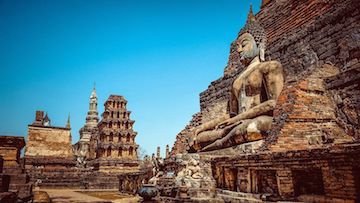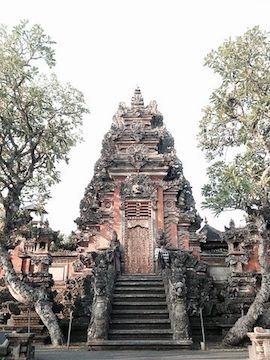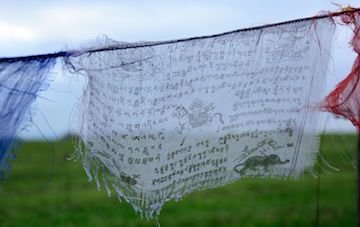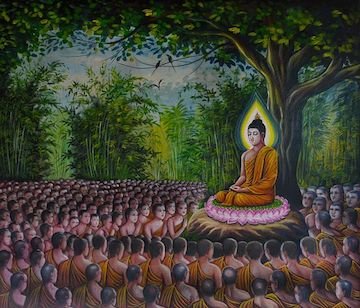The Early Schools of Indian Buddhism Series
The Buddhist Councils — Who, when, where, and why?
Part 2

The growth of the wandering community of Buddhist during the time of the Buddha steadily evolved from a small entourage of his first followers to a steady retinue of followers. Before and during the emergence of Buddhism, there were wanderers from other religions who had established groups and small locations used as gathering places. Besides locations in the village, there were so called hermit dwellings (asrama) on the outskirts of the village and in forests.
The congregation of Buddha’s followers started out with his initial five followers who joined him, and from there it grew to under a hundred followers, who the Buddha gave the task to spread the word of the Buddha in as many locations as possible. Ascetics who belonged to other non-Buddhist orders had to go through a probation period of four months (parivasa), before they were allowed to join.
As a rule, the dwelling space for a follower of the Buddha started out as residences under a tree (rukkhamulasenasanam), and only later did this expand to other locations like caves (guha) and even latter to a monastery (vihara). Eventually the congregation of followers grew to a size where a single location was able to hold hundreds of Buddhist monks. These were called avasa and arama. These locations were at first designated as a residence only, and had strict rules to keep the dwelling space as spartan as possible, to avoid the risk of it becoming a too luxurious and too close resembling the house-holder life.
As the size of Buddha followers grew, so did the risk of disagreement and the rise of dissension among the followers. This was true even when the Buddha was still alive. Although the Buddha didn’t agree that there was disagreement during his life time, he was aware that the risk of it arising was always possible, especially as the size of his retinue grew steadily over the years.

The First Buddhist Council
The first Buddhist Council was held at Rajagaha, right after the Buddha’s final Nirvana.
The Vinaya texts give several reasons why the First Council was held, one of them was the disconcerting account of the monk Subhadda, who had the idea that now that the Buddha had passed away, the monks could relax their rules and not have to live such a strict life with so many rules. In the sutras the suggestion for a council came from the devas, who were concerned about the Buddha’s teachings would lapse after it’s teacher had died. Another very good reason came from the senior monks, who wanted to ensure that the collection of the teachings wouldn’t get lost or misinterpreted among the followers of the Buddha, and recite the teachings in a compiled fashion.
In order to do this, the followers needed the help of Ananda, who was Buddha’s personal assistant for a long time and a treasure trove for remembering all the teachings of the Buddha when he was at his side for years. One of the problems of including Ananda in the First Council, was that only Arhats, who were beyond training (asekha), were allowed to partake in the council’s sessions. Ananda was still a follower in training (sekha), but as the Theravada Vinaya mentions, on the eve of the First Council, he became an Arhat. The Sarvastivada Vinaya disagrees, and simply mentions that Ananda got a waiver for not being an Arhat.
The First Council was headed by a very senior follower, named Maha-kassapa. The number of participants was limited to five hundred. The Vinaya basket (pitaka) of teachings was assigned to be recited by Upali, and the Dhamma basket (pitaka) was assigned to be recited by Ananda.
During the proceedings of the First Council, all followers approved both recitations, except for two senior followers named Gavampati and Purana. Maha-kassapa had successfully won the approval of all the senior monks, but Gavampati remained neutral, as he did not fully accept the proceedings of the Council. Purana did not accept the recitation as the words of the Buddha, and was insisting on including eight additional rules about food into the Vinaya basket. Although this did not lead to a schism in the community of followers, it shows that it is hard to get approval from such a large size of followers during the First Council.
The accounts of the first council’s recitation of the Vinaya rules and the Dhamma teachings are not fully coherent between the Buddhist schools. Especially the arrangement of the teachings (dhamma pitaka) differ, hinting at the fact that they were put into collections separately by each school, or even re-compiled / re-arranged / enlarged at later dates according to each school’s preference.
According to the Theravada Vinaya, the Vinaya included the 4 Parajikas, etc..; the sutras included the five Nikayas (collection of discourses).
According to the Mahisasaka Vinaya, the Vinaya included the 4 Parajikas, etc..; the sutras included in the five Agamas (collection of discourses).
According to the Dharmagupta Vinaya, the Vinaya included the 4 Parajikas, etc..; the sutras included in four Agamas and other texts such as Jataka, Vaipulya, Adbhutadharma, Avadana, Upadeka, Arthapada, Dharmapada, Parayana and Sthaviragatha, Ksudraka, Kathavatthu (points of controversy), and even some Abhidharma texts.
According to the Haimavata Vinaya, the Vinaya included a monk and nuns Vinaya, Kathina, Matrka, and Ekottara; the sutras included in four Agamas and other texts such as Dharmapada, Arthapada, Parayana, etc. up to Upadesa, Ksudraka, and even some Abhidharma texts.
According to the Mahasanghika Vinaya, the Vinaya included the codes of conduct rules, the sutras in five Agamas.
According to the Sarvastivada Vinaya, the Vinaya included the 4 Parajikas, etc..; All sutras that start with “thus I have heard” (evam me srutam), Dharmacakra-pravartana sutra, and Abhidharma beginning with the 5 Buddhist precepts.

The Second Buddhist Council
The second Buddhist Council was held at Vaisali, about 100 years after the Buddha’s final Nirvana.
Unlike the First Council, there was no senior follower of the Buddha who was selected to head the Second Council. Instead, a body of referees consisting of eight monks was formed (ubbahika) to deal with the disputations raised, and each school that was present elected their favorite candidate as part of the committee of eight. Four of the eighth monks were from the western areas of India, and 4 monks from the eastern areas.
The school’s texts differ between the reason given why the Second Council was held. The Theravada Vinaya mentions the ten non-permissible actions of the Vajjian monks as the reason, whereas the Sarvastivada account of Vasumitra does not mention these ten actions at all. Instead, Vasumitra attributes the splitting of the Sangha to the five points of Mahadeva. This sounds like the Sthaviravada school accentuated the importance of the codes of conduct, whereas the Sarvastivada school put stress on doctrinal disagreements.
The earliest sources do mention the ten non-permissible actions performed by the Vajjian monks, but there is disagreement in how each should be interpreted.
The ten non-permissible actions, along with the Theravada interpretation and the rule against it, as found in the Pali texts, are:

Since the Mahisasaka and Sarvastivada schools didn’t mention point 4 separately, they seem to have borrowed a point from the five Mahadeva points, that will be covered next, to make it a list of ten.
Vasumitra’s account, who was a Sarvastivada monk in the first century A.D., along with two other elders of the same school, Bhavya and Vinitadeva, refers to Mahadeva’s five points as being the real reason why the Sangha split into two schools at the Second Council, into the Mahasamghika and Sthaviravada. From a standpoint of weighing the seriousness of this list of five, these disagreements seem way more consequential than the previous list of ten:
On account of the differences (of opinion) among the four groups of people in discussing the five points (pancavastuni) of Mahadeva, the Buddhist Sangha was divided into two schools: the Mahasamghika, an the the Sthaviravada. The four groups of monks that were present: 1. the Naga group, 2. the border country (pratyantika) group, 3. the learned (Bahusrutiya) group, and 4. the venerable (Sthavira) group.
Mahadeva’s five contentious points are:

The Theravada vehemently deny all these points about the Arhat. What the first four points seemed to establish, is the differentiation between the Arhat ideal and the aim for Buddhahood; and from a later fully-developed Mahayana perspective, to make ‘room’ for the ideal of the Bodhisattva as a better aim according to the Northern Buddhist schools that had evolved in the first century A.D. Buddhaghosa attributes these five points to the Mahasamghika school.
Whether it was the ten non-permissible Vinaya rules or Mahadeva’s five points, it sounds plausible that both were responsible for the split at the Second Council. Both causes point to a division of Buddhism into Southern Buddhist Arhat ideals and Northern Buddhist Mahayana ideal. The Mahasamghika school can be considered as the forerunner of the start of Mahayana. In the Mahavastu, the first book of the Vinaya of the Lokottaravada, a branch school of the Mahasamghika, includes many Mahayana traces.
In the next article, the third and fourth Buddhist Councils will be discussed.

I will flag comment spam at 1% strength. If you keep on spamming my post, I will flag you at 100%. I don't care if you have limited English abilities, write a couple of sentences about this article, no copy-paste, please. I will flag: one sentence comments, links to your blog and begging for up-votes and follows. Also, I will flag comments that have nothing to do with my blog's article. I will also check your comment section to see if you have been comment spamming on other blogs.


 A link to My Blog
A link to My Blog
@reddust Well done, well summarized. A fun fact I enjoy is these Eastern religions all have an assumption of Circular Time in the key philosophies in the East, everything repeats again and again. Where as in the West we hold the fundamental assumption of Linear Time, you can't go back, things happen and then time marches forwards.
Kali Yuga and the cycles of timemake sense to me. Linear time has always been a bit confusing to me but maybe that is because I am a bit dyslexic ...hahaha
As people we will always have differing opinions and you would think arahats and bodhisattvas, you know the enlightened ones could work their differences!
When I want to learn about a new system I have to understand the big picture. My first lessons were about Buddha's life and why he decided to teach argumentative opinionated humans. At first he didn't want to because he was afraid we would take our reflection of self mirrored by the mind as our true self. A Deva convinced him he should try and he taught the Way until he was 80 years old. Unlike Jesus or Odin he did not hang from a tree or cross to die into the spirit. There was no sacrifice of eyes or the body. The sacrifice was done within his mind which is hard to grasp...hehehe
some good things which i know about buddhism in my experience Buddhism is a method for discovering peace inside oneself. It is a religion that causes us to discover the joy and satisfaction we look for. Buddhists create internal peace, generosity and intelligence through their day by day practice; and after that offer their involvement with others conveying genuine advantage to this world. They try not to harm others and to live peacefully and gently,
It is true that Buddhism preaches compassion, wisdom, sympathetic joy, loving kindness. That is ideal. However, institutions aren't human, even though humans run them. Institutions live longer than humans, and the pyramid structure of authority tends to attract people who want power, and this has been a problem with Buddhist institutions since the first council. It is interesting to see how the council of humans handled these problems. I have learned a lot from their mistakes and successes, that's why I like reading history.
right
I am not a Buddhist, this information will be my knowledge of Buddhism, which I know Buddhists are very much in India, whether India has a role to Buddhism.
I have heard the calf is the idol of the budha whether it has a history?
thanks @reddust
If you like history @milend this will be an interesting series for you. I love history because it shows me how I ended up where I am today, cause and effect!
This is awesome dude, really enjoyed reading it - it's written perfectly! This is exactly what Steemit is perfect for, this post seriously deserves a much bigger upvote than I can give it!
Thank you @aflatunnisa, I will tell my Husband, he is helping me write this series so I have more time to paint. I am enjoying writing about Buddhism and working with my husband.
To listen to the audio version of this article click on the play image.

Brought to you by @tts. If you find it useful please consider upvoting this reply.
@reddust,
As a Buddhist I also learned a lot by this article! My dear friend, I am awaiting to read the 3rd and 4th Buddhist Councils!
Thank you~
@theguruasia, this will be a long series, Buddhism is over 2500 years old. Our outline has 17 articles...hahaha
@reddust,
But it has only few Buddhist Councils happened in the history!
Cheers~
The series is about all the dead Buddhist schools and the ones that survived...the councils are part of the series.
A pretty complete post I believe that Buddhism is a constant learning. What was the most striking thing about Buddhism?
What is the most striking thing about Buddhism you have learned so far @denissemata? The reason I was attracted to Buddhism was the systematic way the teachings removed my habit patterns that were causing me a lot of suffering and therefore causing suffering for my family. I wanted to become a better person so I could help my children grow up to be good people.
I think reading this is the best. That you changed your life in search of changing patterns that hurt you and your family. For everything you write about Buddhism. This was the one that brought light and peace to your life and that is really wonderful. At the same time I think that you are really good, it shows that Buddhism is not learned from one day to the next and you have dedicated a lot to yourself.
Very interesting and informative. Great subject, have always been interested but never really looked closely. I found it particularly interesting that it didn't take long for there to be disagreements and discontent in the followers, even Buddists ! Appreciate this effort very much. Peace and goodwill.
Many Buddhists were established in Buddhism which had been introduced since many days, Buddhism would be adopted, many people lived in caves and,, yesIn this post-rich history you have told us about a lot of good history, which we did not know, thank you and yes I have read the first part, the second party has been very good, will you say that you are posting a lot of trouble thank you with this extraordinary information. To post the posts